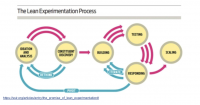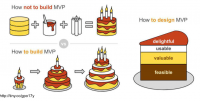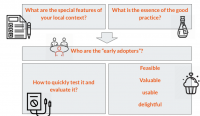By Loris Gherra
As the concept of “Lean Design Methodology for innovation” was the focus of the kick-off meeting in Paris, last February, the aim of Murcia meeting, held at the beginning of June, was to support the Innovato-R partner cities to get clear about the transfer of the good practices and about how to proceed with the testing of their local implementation.
In the Murcia’s session, the City of Turin, the project leader partner, wanted to concentrate the effort on methodologies and skills to guide partners step by step “About what has to be done, at local level, to export the good practice introduced by Turin’s Innova.TO project”, said lead expert Fabio Sgaragli.
Cosimo Panetta was the expert that Turin invited to the Paris meeting, to illustrate the correct approach for building a pilot, using the Lean Design Methodology (read the article).
In Murcia, another expert, Liat Rogel, founder of HousingLab, freelance service designer and design teacher, was called to guide the partner cities, with the MVP technique, to understand their Capacity Building, focusing on short term actions in their own contexts.
The objective was to frame, for each participating city, its local context and its characteristics, applying start-up methodologies, bringing examples of companies and projects, to identify for each public administration the minimum action that can be implemented in the short term. Without losing the big picture and the long-term objectives.
Liat Rogel stated that “It is really important to understand that each participant has to really focus on its own special features before implementing the best practices. The chosen methodology (the Lean Approach and the Minimum Viable Product) is innovative for the Public Administration. The MVP is nothing else than a small version of the product: it is usable, flexible and user-friendly”.
The experts – Pietro Elisei, Liat Rogel and Fabio Sgaragli – suggested to the network members to undergo a quick test in order to evaluate whether they took the right steps before the actual transfer of the best practice.
The concept to be applied to the transfer of best practices should be the “Copy, Adapt and Paste” of the Capacity Building Methodology, i.e. the same concept also used by the McDonald's restaurants when adapting its food offer to the taste of consumers in different countries.
In order to implement the best practices, each partner city should be able to provide an answer to a few simple questions. They should indeed be able to define what are the special features of their local context, what is the essence of the good practice, who are the “early adopters”, and the way to quickly test and evaluate the impact of the best practice.
The Lean Approach

The Minimum Viable Product
A minimum viable product (MVP) is a development technique in which a new product or website is developed with a reduced amount of features, in order to satisfy the needs of early adopters. The final, complete set of features is only designed and developed after considering the feedbacks from the product users.
MVP is the most pared down version of a product that can still be released. It has enough value that people are willing to use it or buy it initially. It demonstrates enough future benefits to retain early adopters. Moreover it provides a feedback loop to guide future development


Liat Rogel suggested to use “User Journey” during testing. User journey map is a visualization of an individual relationship with a product/brand over time and across different channels.
While user journey maps come in all shapes and formats, they are generally represented as a timeline of all touch points between a user and a product. This timeline contains information about all channels that users use to interact with a product.
Good practice means to create several user journeys for different users, such as public employees (maybe of different segments), yourself and your team, your ULG, other stakeholders.
“The important lesson coming from the practice of Turin’s InnovaTO project – said Pietro Elisei, Innovato-R Project expert – consists in that Public Administration officers have been put in the centre of the transformation both of their own role and of that of the Public Administration itself. In particular, the project enhanced the officers that proved to be particularly brilliant and innovative and that were capable to be the change makers”.
All the partner cities will dedicate this summer to work on planning the implementation and test, and the next partners’ meeting in Rotterdam will be a useful check point for this process.
In Rotterdam, the partner cities will work on all the aspects of the organization, to best receive the innovations inside the Public Administration.
